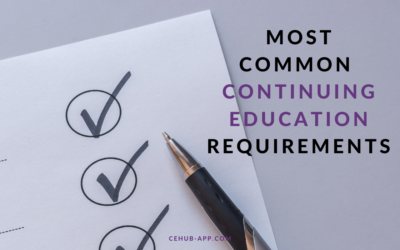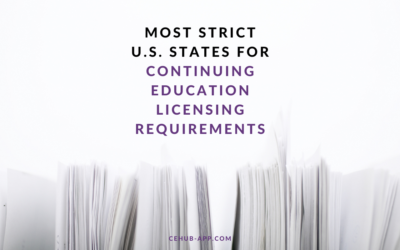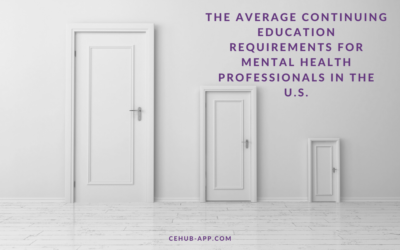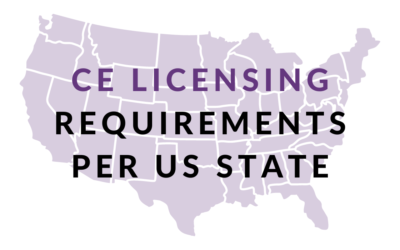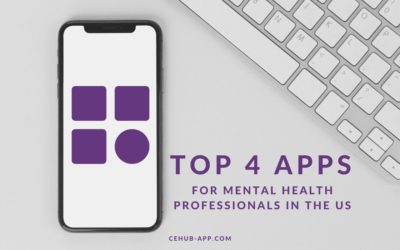CE credits are the educational equivalent of money. For mental health professionals, CE credits are not just something you can afford to go without. They are required for licensure, license renewal, and of course, your professional development. Here’s how to track them.
The CE Credit Audit
This is the first step you can take toward tracking your CE credits. The audit is essentially a list of courses and classes you’ve taken in which you received certificates, credit hours, or continuing education units (CEUs). There are some apps (including ours) that can do this for you. The list of courses isn’t perfect, however. It’s based on your memory and dependent on which courses are listed on the certificates of completion you received. Some providers don’t list all the classes on the certificate so there may be some that aren’t included in your audit.
It’s also just a snapshot of what you’ve done so far, not a future-oriented list. So if you’ve already taken the courses on your list, they won’t be included in the audit. You can always run it again later to see what else is missing.
The Provider
Once you take care of the CE credit audit you’re ready for step two: locating courses. Not every course you take will be recognized by your licensing board or profession, but most reputable providers will list their courses with all the accrediting organizations they are compatible with. You can then contact them directly to find out if they offer the classes you need and how much it will cost to take them relative to what they will count for CE credits.
Be sure to ask how long it will take to complete the course and whether there is any additional study required after finishing it. Some providers offer a final assessment or exam, for instance, while others don’t. You might also find that the price of a class drops if you pay for multiple credits at once rather than one at a time.
How Many Credits Do You Need?
First up is figuring out how many credits you need for your license renewal. The number of credits required will depend on what profession is and where you live. If the answer is anything but “more than I can afford to go without,” then read on, because we’ve got some options for you.
What Type of Course is Right For You?
The next thing to do is figure out what type of course would be most helpful. Some courses are only worth 0.5 CE credits, some are 1 or more, and many can be used toward more than one requirement at a time. So ask yourself what you need, and check out what’s available.
How to Choose Where to Take the Course
Once you figure out what type of course you need, it’s time to tally up your options. The list of providers in your area will be helpful here, but make sure they offer exactly what you need, or else they won’t be much help. Contact them by phone, email, or in-person to find out how long it takes to complete the course, if there are any fees involved, and any additional requirements after completing the course.
After you’ve located a provider that offers what you need at an affordable rate in a timely manner with no extra hoops to jump through, it’s time to register. Some states require that you register with them before enrolling in a course, so call and ask if there’s anything else you need to do. Then get studying!
How to Track Your Credits
When all is said and done, you’ll need to figure out how many credits you earned. Then it’s time to send in your forms and pay your fees.
Some states require that you complete an annual form documenting all the CE credits you earn over the course of the year. That way, they know exactly how many CE credits you’ve earned and can cross-reference them with your continuing education report to make sure that everything adds up.
Why Take Continuing Education Classes?
So what do CE credits actually get you? Well, if it’s a requirement for your continued licensure in some capacity, then more than anything they get you closer to the end goal. If you’re not required to take them by an outside force, however, then why bother?
The answer comes easily after a little self-reflection. We all have to deal with “busy work,” tasks that we don’t think about if they aren’t brought up directly and which hold no intrinsic value beyond keeping us busy. Hopefully continuing education classes aren’t viewed the same way. They keep us occupied and hopefully also engaged with new techniques related to mental health. You’ll widen your knowledge base and puzzle together different concepts you’ve learned over time, create new professional connections with like-minded professionals, and learn some interesting stuff along the way. So while it may not be the most exciting part of your day, take heart in knowing that it’s worth it in the end.
Final Thoughts
It’s important to take the time and track your continuing education credits. It will save you money on course registration fees, can give you something to do with that extra free time, adding up all the hours you spent working towards your goals can be an eye-opening experience, and most of all it gets you one step closer to gaining new knowledge and skills.
The end result of all this? You’ll get to add new skills and experience to your resume, connect with professionals who share your interests, and earn credit towards licensure. Looking for a better way to track your credits? Check out our app, CE Hub – it’ll help you get the most out of your continuing education classes.



